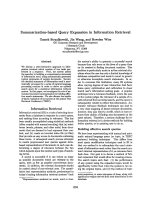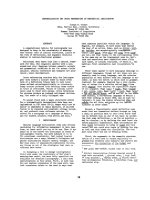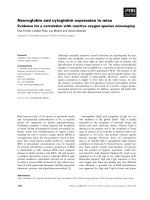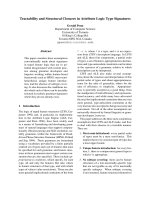Báo cáo khoa học: "Homophones and Tonal Patterns in English-Chinese Transliteration" doc
Bạn đang xem bản rút gọn của tài liệu. Xem và tải ngay bản đầy đủ của tài liệu tại đây (205.69 KB, 4 trang )
Proceedings of the ACL-IJCNLP 2009 Conference Short Papers, pages 21–24,
Suntec, Singapore, 4 August 2009.
c
2009 ACL and AFNLP
Homophones and Tonal Patterns in English-Chinese Transliteration
Oi Yee Kwong
Department of Chinese, Translation and Linguistics
City University of Hong Kong
Tat Chee Avenue, Kowloon, Hong Kong
Abstract
The abundance of homophones in Chinese
significantly increases the number of similarly
acceptable candidates in English-to-Chinese
transliteration (E2C). The dialectal factor also
leads to different transliteration practice. We
compare E2C between Mandarin Chinese and
Cantonese, and report work in progress for
dealing with homophones and tonal patterns
despite potential skewed distributions of indi-
vidual Chinese characters in the training data.
1 Introduction
This paper addresses the problem of automatic
English-Chinese forward transliteration (referred
to as E2C hereafter).
There are only a few hundred Chinese charac-
ters commonly used in names, but their combina-
tion is relatively free. Such flexibility, however,
is not entirely ungoverned. For instance, while
the Brazilian striker Ronaldo is rendered as 朗拿
度 long5-naa4-dou6 in Cantonese, other pho-
netically similar candidates like 朗娜度 long5-
naa4-dou6 or 郎拿刀 long4-naa4-dou1
1
are least
likely. Beyond linguistic and phonetic properties,
many other social and cognitive factors such as
dialect, gender, domain, meaning, and perception,
are simultaneously influencing the naming proc-
ess and superimposing on the surface graphemic
correspondence.
The abundance of homophones in Chinese fur-
ther complicates the problem. Past studies on
phoneme-based E2C have reported their adverse
effects (e.g. Virga and Khudanpur, 2003). Direct
orthographic mapping (e.g. Li et al., 2004), mak-
ing use of individual Chinese graphemes, tends
1
Mandarin names are transcribed in Hanyu Pinyin
and Cantonese names are transcribed in Jyutping pub-
lished by the Linguistic Society of Hong Kong.
to overcome the problem and model the charac-
ter choice directly. Meanwhile, Chinese is a
typical tonal language and the tone information
can help distinguish certain homophones. Pho-
neme mapping studies seldom make use of tone
information. Transliteration is also an open
problem, as new names come up everyday and
there is no absolute or one-to-one transliterated
version for any name. Although direct ortho-
graphic mapping has implicitly or partially mod-
elled the tone information via individual charac-
ters, the model nevertheless heavily depends on
the availability of training data and could be
skewed by the distribution of a certain homo-
phone and thus precludes an acceptable translit-
eration alternative. We therefore propose to
model the sound and tone together in E2C. In
this way we attempt to deal with homophones
more reasonably especially when the training
data is limited. In this paper we report some
work in progress and compare E2C in Cantonese
and Mandarin Chinese.
Related work will be briefly reviewed in Sec-
tion 2. Some characteristics of E2C will be dis-
cussed in Section 3. Work in progress will be
reported in Section 4, followed by a conclusion
with future work in Section 5.
2 Related Work
There are basically two categories of work on
machine transliteration. First, various alignment
models are used for acquiring transliteration
lexicons from parallel corpora and other re-
sources (e.g. Kuo and Li, 2008). Second, statis-
tical models are built for transliteration. These
models could be phoneme-based (e.g. Knight and
Graehl, 1998), grapheme-based (e.g. Li et al.,
2004), hybrid (Oh and Choi, 2005), or based on
phonetic (e.g. Tao et al., 2006) and semantic (e.g.
Li et al., 2007) features.
Li et al. (2004) used a Joint Source-Channel
Model under the direct orthographic mapping
21
(DOM) framework, skipping the middle phone-
mic representation in conventional phoneme-
based methods, and modelling the segmentation
and alignment preferences by means of contex-
tual n-grams of the transliteration units. Al-
though DOM has implicitly modelled the tone
choice, since a specific character has a specific
tone, it nevertheless heavily relies on the avail-
ability of training data. If there happens to be a
skewed distribution of a certain Chinese charac-
ter, the model might preclude other acceptable
transliteration alternatives. In view of the abun-
dance of homophones in Chinese, and that
sound-tone combination is important in names
(i.e., names which sound “nice” are preferred to
those which sound “monotonous”), we propose
to model sound-tone combinations in translitera-
tion more explicitly, using pinyin transcriptions
to bridge the graphemic representation between
English and Chinese. In addition, we also study
the dialectal differences between transliteration
in Mandarin Chinese and Cantonese, which is
seldom addressed in past studies.
3 Some E2C Properties
3.1 Dialectal Differences
English and Chinese have very different phono-
logical properties. A well cited example is a syl-
lable initial /d/ may surface as in Baghdad 巴格
達 ba1-ge2-da2, but the syllable final /d/ is not
represented. This is true for Mandarin Chinese,
but since ending stops like –p, –t and –k are al-
lowed in Cantonese syllables, the syllable final
/d/ in Baghdad is already captured in the last syl-
lable of 巴格達 baa1-gaak3-daat6 in Cantonese.
Such phonological difference between Manda-
rin Chinese and Cantonese might also account
for the observation that Cantonese translitera-
tions often do not introduce extra syllables for
certain consonant segments in the middle of an
English name, as in Dickson, transliterated as 迪
克遜 di2-ke4-xun4 in Mandarin Chinese and 迪
臣 dik6-san4 in Cantonese.
3.2 Ambiguities from Homophones
The homophone problem is notorious in Chinese.
As far as personal names are concerned, the
“correctness” of transliteration is not clear-cut at
all. For example, to transliterate the name Hilary
into Chinese, based on Cantonese pronunciations,
the following are possibilities amongst many
others: (a) 希拉利 hei1-laai1-lei6, (b) 希拉莉
hei1-laai1-lei6, and (c) 希拉里 hei1-laai1-lei5.
The homophonous third character gives rise to
multiple alternative transliterations in this exam-
ple, where orthographically 利 lei6, 莉 lei6 and
里 lei5 are observed for “ry” in transliteration
data. One cannot really say any of the combina-
tions is “right” or “wrong”, but perhaps only
“better” or “worse”. Such judgement is more
cognitive than linguistic in nature, and appar-
ently the tonal patterns play an important role in
this regard. Hence naming is more of an art than
a science, and automatic transliteration should
avoid over-reliance on the training data and thus
missing unlikely but good candidates.
4 Work in Progress
4.1 Datasets
A common set of 1,423 source English names
and their transliterations
2
in Mandarin Chinese
(as used by media in Mainland China) and Can-
tonese (as used by media in Hong Kong) were
collected over the Internet. The names are
mostly from soccer, entertainment, and politics.
The data size is admittedly small compared to
other existing transliteration datasets, but as a
preliminary study, we aim at comparing the
transliteration practice between Mandarin speak-
ers and Cantonese speakers in a more objective
way based on a common set of English names.
The transliteration pairs were manually aligned,
and the pronunciations for the Chinese characters
were automatically looked up.
4.2 Preliminary Quantitative Analysis
Cantonese
Mandarin
Unique name pairs 1,531 1,543
Total English segments 4,186 4,667
Unique English segments 969 727
Unique grapheme pairs 1,618 1,193
Unique seg-sound pairs 1,574 1,141
Table 1. Quantitative Aspects of the Data
As shown in Table 1, the average segment-name
ratios (2.73 for Cantonese and 3.02 for Mandarin)
suggest that Mandarin transliterations often use
more syllables for a name. The much smaller
number of unique English segments for Manda-
rin and the difference in token-type ratio of
grapheme pairs (3.91 for Mandarin and 2.59 for
Cantonese) further suggest that names are more
consistently segmented and transliterated in
Mandarin.
2
Some names have more than one transliteration.
22
4.2.1 Graphemic Correspondence
Assume grapheme pair mappings are in the form
<e
k
, {c
k1
,c
k2
,…,c
kn
}>, where e
k
stands for the kth
unique English segment from the data, and
{c
k1
,c
k2
,…,c
kn
} for the set of n unique Chinese
segments observed for it. It was found that n
varies from 1 to 10 for Mandarin, with 34.9% of
the distinct English segments having multiple
grapheme mappings, as shown in Table 2. For
Cantonese, n varies from 1 to 13, with 31.5% of
the distinct English segments having multiple
grapheme mappings. The proportion of multiple
mappings is similar for Mandarin and Cantonese,
but the latter has a higher percentage of English
segments with 5 or more Chinese renditions.
Thus Mandarin transliterations are relatively
more “standardised”, whereas Cantonese trans-
literations are graphemically more ambiguous.
n Cantonese Mandarin
>=5 5.3% 3.3%
4 4.0% 4.4%
3 6.2% 7.2%
2 16.0% 20.0%
1 68.5% 65.1%
Example
<le, {列, 利, 勒, 尼,
李, 歷, 烈, 爾, 理,
萊, 路, 里, 雷}>
<le, {列, 利, 勒, 歷,
爾, 理, 萊, 裏, 路,
雷}>
Table 2. Graphemic Ambiguity of the Data
4.2.2 Homophone Ambiguity (Sound Only)
Table 3 shows the situation with homophones
(ignoring tones). For example, all five characters
利莉李里理 correspond to the Jyutping lei. De-
spite the tone difference, they are considered
homophones in this section.
n Cantonese Mandarin
>=5 3.3% 1.9%
4 4.0% 2.5%
3 5.8% 5.7%
2 16.3% 20.7%
1 70.5% 69.2%
Example
<le, {ji, laak, lei,
leoi, lik, lit, loi, lou,
nei}>
<le, {er, lai, le, lei,
li, lie, lu}>
Table 3. Homophone Ambiguity (Ignoring Tone)
Assume grapheme-sound pair mappings are in
the form <e
k
, {s
k1
,s
k2
,…,s
kn
}>, where e
k
stands for
the kth unique English segment, and
{s
k1
,s
k2
,…,s
kn
} for the set of n unique pronuncia-
tions (regardless of tone). For Mandarin, n var-
ies from 1 to 7, with 30.8% of the distinct Eng-
lish segments having multiple sound mappings.
For Cantonese, n varies from 1 to 9, with 29.5%
of the distinct English segments having multiple
sound mappings. Comparing with Table 2 above,
the downward shift of the percentages suggests
that much of the graphemic ambiguity is a result
of the use of homophones, instead of a set of
characters with very different pronunciations.
4.2.3 Homophone Ambiguity (Sound-Tone)
Table 4 shows the situation of homophones with
both sound and tone taken into account. For ex-
ample, the characters 利莉 all correspond to lei6
in Cantonese, while 李里理 all correspond to
lei5, and they are thus treated as two groups.
Assume grapheme-sound/tone pair mappings
are in the form <e
k
, {st
k1
,st
k2
,…,st
kn
}>, where e
k
stands for the kth unique English segment, and
{st
k1
,st
k2
,…,st
kn
} for the set of n unique pronun-
ciations (sound-tone combination). For Manda-
rin, n varies from 1 to 8, with 33.5% of the dis-
tinct English segments corresponding to multiple
Chinese homophones. For Cantonese, n varies
from 1 to 10, with 30.8% of the distinct English
segments having multiple Chinese homophones.
n Cantonese Mandarin
>=5 4.1% 2.8%
4 4.8% 3.3%
3 6.1% 6.8%
2 15.8% 20.7%
1 69.2% 66.5%
Example
<le, {ji5, laak6, lei5,
lei6, leoi4, lik6, lit6,
loi4, lou6, nei4}>
<le, {er3, lai2, le4,
lei2, li3, li4, lie4,
lu4}
Table 4. Homophone Ambiguity (Sound-Tone)
The figures in Table 4 are somewhere between
those in Table 2 and Table 3, suggesting that a
considerable part of homophones used in the
transliterations could be distinguished by tones.
This supports our proposal of modelling tonal
combination explicitly in E2C.
4.3 Method and Experiment
The Joint Source-Channel Model in Li et al.
(2004) was adopted in this study. However, in-
stead of direct orthographic mapping, we model
the mapping between an English segment and the
pronunciation in Chinese. Such a model is ex-
pected to have a more compact parameter space
as individual Chinese characters for a certain
English segment are condensed into homophones
defined by a finite set of sounds and tones. The
model could save on computational effort, and is
less affected by any bias or sparseness of the data.
We refer to this approach as SoTo hereafter.
Hence our approach with a bigram model is as
follows:
23
∏
=
−−
><><=
><><><=
=
K
k
kkkk
kk
kk
stesteP
stestesteP
stststeeePSTEP
1
11
2211
2121
),|,(
),, ,,,,(
), ,,,, ,,(),(
where E refers to the English source name and
ST refers to the sound/tone sequence of the trans-
literation, while e
k
and st
k
refer to kth segment
and its Chinese sound respectively. Homo-
phones in Chinese are thus captured as a class in
the phonetic transcription. For example, the ex-
pected Cantonese transliteration for Osborne is
奧斯邦尼 ou3-si1-bong1-nei4. Not only is it
ranked first using this method, its homophonous
variant 奧施邦尼 is within the top 5, thus bene-
fitting from the grouping of the homophones,
despite the relatively low frequency of <s,施>.
This would be particularly useful for translitera-
tion extraction and information retrieval.
Unlike pure phonemic modelling, the tonal
factor is modelled in the pronunciation transcrip-
tion. We do not go for phonemic representation
from the source name as the transliteration of
foreign names into Chinese is often based on the
surface orthographic forms, e.g. the silent h in
Beckham is pronounced to give 漢姆 han4-mu3
in Mandarin and 咸 haam4 in Cantonese.
Five sets of 50 test names were randomly ex-
tracted from the 1.4K names mentioned above
for 5-fold cross validation. Training was done
on the remaining data. Results were also com-
pared with DOM. The Mean Reciprocal Rank
(MRR) was used for evaluation (Kantor and
Voorhees, 2000).
4.4 Preliminary Results
Method
Cantonese Mandarin
DOM 0.2292 0.3518
SoTo 0.2442 0.3557
Table 5. Average System Performance
Table 5 shows the average results of the two
methods. The figures are relatively low com-
pared to state-of-the-art performance, largely due
to the small datasets. Errors might have started
to propagate as early as the name segmentation
step. As a preliminary study, however, the po-
tential of the SoTo method is apparent, particu-
larly for Cantonese. A smaller model thus per-
forms better, and treating homophones as a class
could avoid over-reliance on the prior distribu-
tion of individual characters. The better per-
formance for Mandarin data is not surprising
given the less “standardised” Cantonese translit-
erations as discussed above. From the research
point of view, it suggests more should be consid-
ered in addition to grapheme mapping for han-
dling Cantonese data.
5 Future Work and Conclusion
Thus we have compared E2C between Mandarin
Chinese and Cantonese, and discussed work in
progress for our proposed SoTo method which
more reasonably treats homophones and better
models tonal patterns in transliteration. Future
work includes testing on larger datasets, more in-
depth error analysis, and developing better meth-
ods to deal with Cantonese transliterations.
Acknowledgements
The work described in this paper was substan-
tially supported by a grant from City University
of Hong Kong (Project No. 7002203).
References
Kantor, P.B. and Voorhees, E.M. (2000) The TREC-
5 Confusion Track: Comparing Retrieval Methods
for Scanned Text. Information Retrieval, 2(2-3):
165-176.
Knight, K. and Graehl, J. (1998) Machine Translit-
eration. Computational Linguistics, 24(4):599-612.
Kuo, J-S. and Li, H. (2008) Mining Transliterations
from Web Query Results: An Incremental Ap-
proach. In Proceedings of SIGHAN-6, Hyderabad,
India, pp.16-23.
Li, H., Zhang, M. and Su, J. (2004) A Joint Source-
Channel Model for Machine Transliteration. In
Proceedings of the 42nd Annual Meeting of ACL,
Barcelona, Spain, pp.159-166.
Li, H., Sim, K.C., Kuo, J-S. and Dong, M. (2007)
Semantic Transliteration of Personal Names. In
Proceedings of the 45th Annual Meeting of ACL,
Prague, Czech Republic, pp.120-127.
Oh, J-H. and Choi, K-S. (2005) An Ensemble of
Grapheme and Phoneme for Machine Translitera-
tion. In R. Dale et al. (Eds.), Natural Language
Processing – IJCNLP 2005. Springer, LNAI Vol.
3651, pp.451-461.
Tao, T., Yoon, S-Y., Fister, A., Sproat, R. and Zhai, C.
(2006) Unsupervised Named Entity Transliteration
Using Temporal and Phonetic Correlation. In Pro-
ceedings of EMNLP 2006, Sydney, Australia,
pp.250-257.
Virga, P. and Khudanpur, S. (2003) Transliteration of
Proper Names in Cross-lingual Information Re-
trieval. In Proceedings of the ACL2003 Workshop
on Multilingual and Mixed-language Named Entity
Recognition.
24









